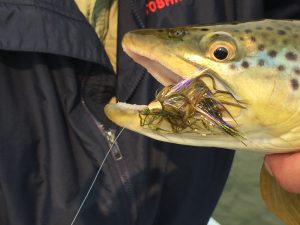Archive for September 2017
Bighorn River (Part II)

While not a shiner pattern, streamers have generally been very effective on the Bighorn River this year.
My Dad, Dennis, and I were out on the Bighorn River in early May. The Bighorn Mountains experienced a tremendous year in terms of snowpack. As of May, it was still something like 230% of normal and the melting snow has to go somewhere. As with most tail waters, extremes on either side of the spectrum create a no win situation for those controlling the release of water from the dam. For more on the history of the Yellowtail Dam, take a look at part I of this series.
In this case, those of us brave enough to give the high flows a shot weren’t disappointed. We spent the entire week before our trip watching the numbers, however, as the CFS (Cubic Feet per Second) rose almost each day. By the time our boat was ready to hit the water, we were expecting to float down at about 14,000 CFS. I’m not going to pretend like that didn’t give us second thoughts about heading out to Ft. Smith.
Standard flows on the Bighorn are in the 2,500 to 3,000 CFS range.
When you fish the Bighorn once or twice a year, like I do, you learn just enough to surprise yourself by remembering certain holes from the previous visit (“that seam right there is where I caught a 20 inch rainbow last July”). Or you can start to impress your buddies by naming the areas you will be meeting for lunch.
“Let’s meet at noon on Crow Beach.”
“Where is Crow Beach?”
“It’s just around the bend, downstream from Rattlesnake Island.”
“Oh … still not helpful.”
Believe it or not, fishing the Bighorn River in flows reaching 14,000 CFS simplifies the fishing experience. You lose a lot of those islands you were supposed to remember. There aren’t many “beaches” left to stop and eat lunch, or fish, for that matter. The river is humming, and you don’t have to worry about getting to a great wading spot before everyone else. You simply float.
While in the boat, you are definitely moving downstream at a faster rate than usual, but it isn’t something the lesser-experienced rower couldn’t handle. The only additional challenge I find is that the river’s “hydraulics” have changed. By that I mean it is much harder to keep the boat in a steady position a certain distance from the bank. For some reason, the water tends to push you in and out unexpectedly.
The fishing is fairly easy. You don’t get out of the boat much, if at all. So you just throw streamers or nymphs as you meander downstream. In this instance, we found ourselves in a situation uncommon to the Bighorn River. Because the water was entering the river from the top of the dam, it created a phenomenon the locals called a “shiner hatch.” Millions of white, two to three inch minnows went over the dam with the water. Thus, the streamer fishing was fantastic.
Streamer fishing is one of my favorite methods for a number of reasons. (I realize we make floatants. But sometimes dry fly fishing just isn’t practical). First, I’m not the most technically proficient fisherman in the world. Streamer fishing allows me to just throw the damn thing out there, without worrying as much about presentation and drift. There are rules, though, such as getting the streamer as close to the bank as possible. I do try to adhere to that.
This may sound funny, but with streamer fishing, you also get to experience the hits and misses of many fish. In a sense, it’s satisfying to know that you are able to draw fish to the fly, even if you don’t get a full eat. Because the Bighorn is fairly clear, in most areas, you get to watch the entire process in action. You see the streamer working. You actually see the fish hit it. You get a sense of just how aggressive trout can be.
When the hook is set, however, it is a great deal of fun.
While the fishing itself has simplified, getting the boat off the river at the takeout is not so simple. For us, it took three days to perfect our landing. The first day was an absolute disaster. Our goal was to take out at the 13 Mile access. While 13 Mile gives you two take outs to hit, neither one provides much of a “landing strip” in which to slow down and glide right in. Now compound that problem with really high flows.
Despite our foresight to plan way ahead, we missed the first take out. I also lost Dennis at some point in the process (he survived). As we came up on the second takeout, my dad one leg over the side in order to step out and assist the landing. He saw that the river there was still over six feet deep and thought better of it (so he, too, survived). With that, I didn’t get us close enough to the takeout for the anchor to be effective (word of caution, at 14,000 CFS, do not throw the anchor unless you are in slack water. The flows can pull your boat under water).
We were well on our way downstream before we finally got the anchor on the beach about 30 or 40 yards further. It ended up okay, I just had to walk the boat back to the take out. All I can say is … thankfully no one was at the access to see this fiasco.
We returned in August. It was a completely different river, which will be the topic of the third and final post on the Bighorn River.
